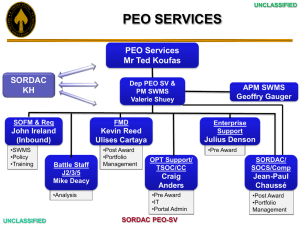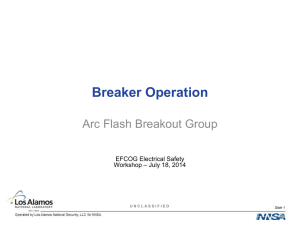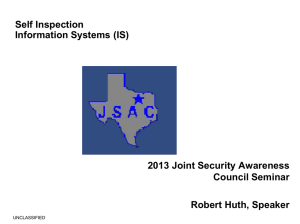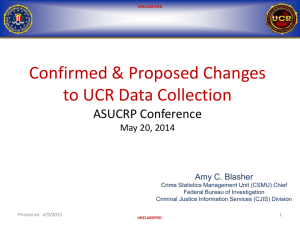The British Mission to Los Alamos
advertisement
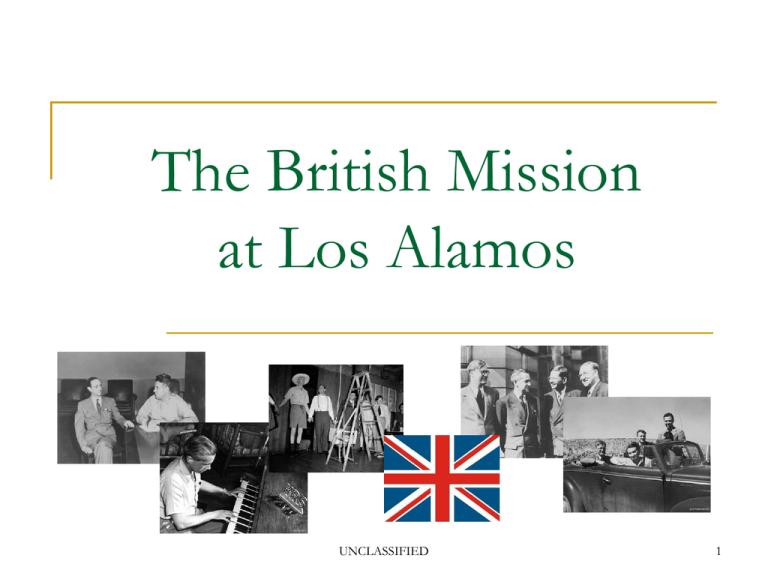
The British Mission at Los Alamos UNCLASSIFIED 1 The Frisch-Peierls Memo Fission is discovered in Germany in 1938 Einstein warns FDR in a letter dated August 2, 1939 Germany invades Poland on September 1, 1939 In early 1940, the FrischPeierls Memo is completed “The attached detailed report concerns the possibility of constructing a ‘super-bomb’ which utilises the energy stored in atomic nuclei as a source of energy. The energy liberated in the explosion of such a super-bomb is about the same as that produced by the explosion of 1,000 tons of dynamite.” UNCLASSIFIED 2 Maud Ray Kent? The British Government sponsors a feasibility study In spring 1940 the Maud Committee is created The “Maud” Committee?? The committee completes its report in July 1941 “..the first bomb would be produced by the end of 1943.” UNCLASSIFIED 3 The Quebec Agreement The Maud report and Pearl Harbor spur the US project British politicians favor independent projects The British project falls behind its US counterpart in 1942 With the lead, the US stops sharing information Britain now tries to salvage the role of junior partner Churchill personally negotiates a deal in July 1943 The Quebec Agreement is signed August 19, 1943 UNCLASSIFIED “In the field of scientific research and development there shall be full and effective interchange of information and ideas..” 4 The British Arrive in America “..I cannot escape the feeling that without active and continuing British interest there probably would have been no atomic bomb to drop on Hiroshima.” The British begin arriving in America immediately Some Brits work on gaseous diffusion Others work on electromagnetic separation The largest group comes to Los Alamos Nobel Laureate Sir James Chadwick leads the group Peierls soon takes the lead at Los Alamos Chadwick remains in DC UNCLASSIFIED 5 A Motley Crew British Subjects Foreign-Born James Chadwick Aage Bohr, consultant (Denmark) Anthony French James Hughes Derrik Littler Carson Mark (Canada) William Marley Donald Marshall Philip Moon William Penney Michael Poole Harold Sheard Tony Skyrme Geoffrey Taylor Ernest Titterton James Tuck Niels Bohr, consultant (Denmark) Egon Bretscher (Switzerland) Boris Davison (Russia) Otto Frisch (Austria) Klaus Fuchs (Germany) Rudolf Peierls (Germany) George Placzek (Czechoslovakia) Joseph Rotblat (Poland) UNCLASSIFIED 6 Klaus Fuchs Fuchs is a German-born member of the communist party He flees Germany in 1933 shortly after Hitler is appointed He completes his PhD at the University of Bristol in 1937 In 1942, Fuchs becomes a British citizen Peierls recruits him to work on the bomb project During his employment at Los Alamos, Fuchs provides the Soviet Union with classified information “The United Kingdom not only failed us, but herself as well.” UNCLASSIFIED 7 Technical Contributions Peierls, Frisch, Bretscher, and Placzek all serve as group leaders Peierls and Fuchs play critical roles in the Hydrodynamics Group Tuck is instrumental in developing the implosion lens system Taylor predicts phenomena associated with the Trinity test Penney measures the blast and serves on the Target Committee UNCLASSIFIED 8 The End of World War II The atomic strikes are launched from Tinian Hiroshima is attacked on August 6, 1945 80,000 are killed immediately by the 15 kiloton blast Nagasaki is bombed on August 9 45,000 are killed immediately by the 21 kiloton blast Japan unconditionally surrenders on August 14 UNCLASSIFIED 9 A Celebration A few weeks after the armistice the British throw a party The British wives take the lead in organizing the event Soup, steak and kidney pie, and trifle are served.. ..as well as whiskey, brandy, and port wine Tuck writes a play satirizing security regulations, housing, and the Trinity test UNCLASSIFIED 10 A New World with New Challenges Several British scientists call for international control The Atomic Energy Act of 1946 prohibits the exchange of atomic information On August 29, 1949 the Soviets test Joe-1 In early 1950 Fuchs is arrested in Britain for espionage A few months later, Julius and Ethel Rosenberg are arrested In October 1952, the UK tests its first bomb UNCLASSIFIED 11 The Legacy of the British Mission General Groves: “On the whole, the contribution of the British was helpful but not vital.” The British made important technical and social contributions Wartime cooperation foreshadowed the Mutual Defense Agreement Under the auspices of the MDA, the US and UK have conducted dozens of full-scale and subcritical nuclear tests UNCLASSIFIED 12 Epilogue Mark becomes a US citizen and serves as T Division leader for 25 years Tuck becomes a US citizen and spends the remainder of his career at Los Alamos Fuchs is released after serving nine years in prison and immigrates to East Germany Penney becomes the “British Oppenheimer” and is knighted Rotblat leaves the project early and later wins the Nobel Peace Prize Peierls is knighted in 1968 UNCLASSIFIED 13 Further Reading John Baylis. Anglo-American Defense Relations, 1939-1984 Margaret Gowing. Britain and Atomic Energy, 1939-1945 Lillian Hoddeson, et al. Critical Assembly: A Technical History of Los Alamos during the Oppenheimer Years, 19431945 Jenifer Mackby and Paul Cornish, eds. U.S.-UK Nuclear Cooperation After 50 Years Ferenc Szasz. British Scientists and the Manhattan Project UNCLASSIFIED 14

